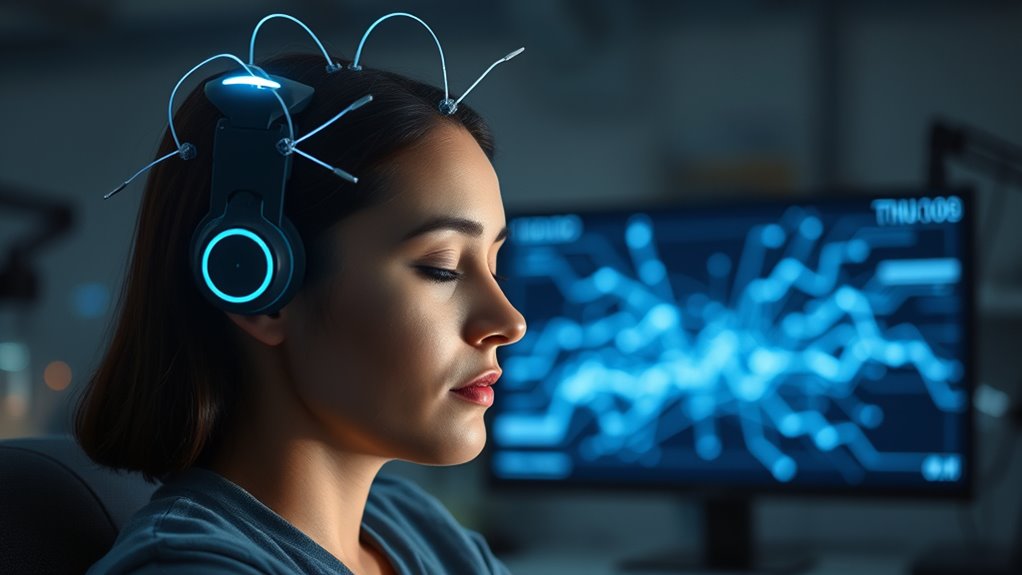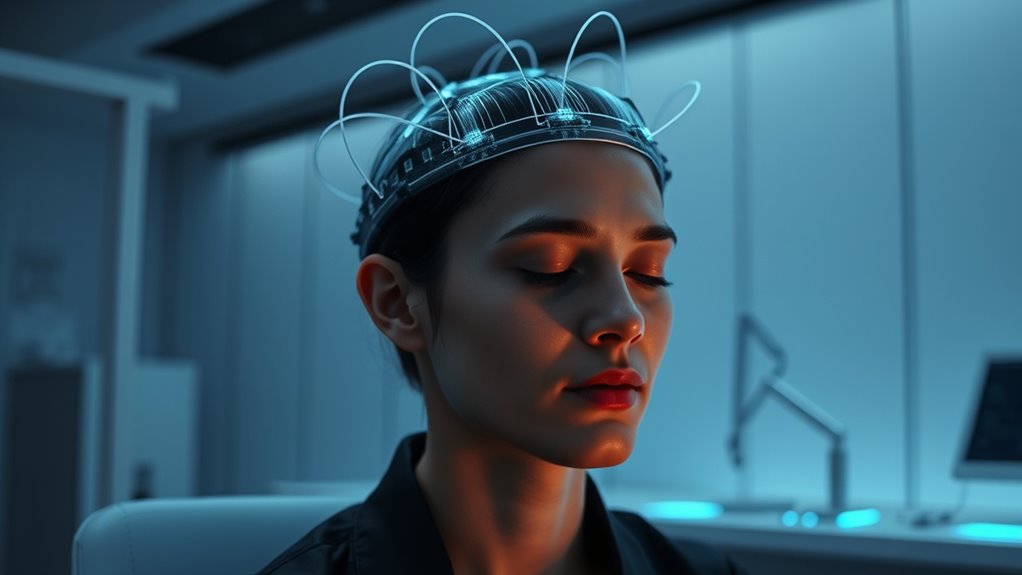Brain-computer interfaces let you type using only your thoughts by translating your neural signals into digital text. They decode electrical activity in your brain, recognizing subtle patterns that represent your intended words. While current systems are improving in accuracy and safety, ethical concerns like privacy and fairness remain important. If you keep exploring, you’ll discover how these advancements could transform communication and what challenges still need addressing.
Key Takeaways
- BCIs enable users to type directly through neural signals, translating thoughts into digital text.
- Advanced neural decoding algorithms improve the accuracy and speed of thought-based typing.
- Ethical considerations include ensuring user consent and protecting neural data privacy during communication.
- Reliable BCI systems require robustness to minimize errors and enhance user confidence in thought-based typing.
- Broad accessibility and fairness are essential to make thought-based typing technologies available to diverse users.

Brain-Computer Interfaces (BCIs) are systems that enable direct communication between the brain and external devices. When you think about typing with pure thought, BCIs make it possible by translating neural signals into digital commands. Central to this process is neural decoding, where algorithms interpret electrical activity in your brain to identify specific intentions or actions. With advanced neural decoding techniques, BCIs can detect subtle patterns in your brain signals, allowing you to spell words, control a cursor, or even operate a robotic limb just by thinking.
BCIs translate neural signals into commands, enabling thought-based control of devices through advanced neural decoding.
As you explore BCI technology for typing, it’s important to consider the ethical implications involved. Privacy becomes a major concern because neural data is incredibly personal—your thoughts, intentions, and mental states could potentially be accessed or misused if safeguards aren’t in place. You need to trust that your brain signals are protected from unauthorized access, especially as BCI systems become more sophisticated and capable of revealing deeper layers of mental activity. Consent is another critical issue: users should have full control over what neural data is collected, how it’s used, and who has access to it. Transparency from developers and researchers helps guarantee that ethical boundaries aren’t crossed in pursuit of technological advancement.
Furthermore, the development of neural decoding algorithms raises questions about accuracy and reliability. If a decoding system misinterprets your brain signals, it could lead to unintended actions or errors, which might cause frustration or harm. As you rely more on these systems, ensuring their precision and robustness becomes essential, not just for usability but also to uphold ethical standards. Researchers are working to improve decoding methods, making sure that the translation from neural activity to digital output is as precise as possible, reducing errors and increasing your confidence in the technology.
Another aspect to consider is accessibility and fairness. As BCI technology advances, it’s essential that it’s accessible to a diverse range of users, not just those with specific disabilities or resources. Ethical deployment involves addressing potential disparities to prevent creating a society where only some can benefit from thought-based typing. Inclusivity ensures that the benefits of neural decoding and BCI systems are shared broadly, supporting fairness and social equity.
In essence, as you venture toward typing with your mind through BCIs, understanding the importance of neural decoding and the ethical considerations surrounding privacy, consent, accuracy, and fairness is vital. These elements shape the responsible development and use of this groundbreaking technology, ensuring it serves you and society ethically and effectively.
Frequently Asked Questions
How Long Does It Take to Develop a New BCI Technology?
When you ask about developing a new BCI technology, the timeline feasibility depends on overcoming significant technological challenges. It can take several years, often a decade or more, to refine concepts, test safety, and guarantee reliability. Advances in neural signal processing and hardware are essential. You should expect a lengthy process, as researchers need to address complex issues like accuracy, latency, and user comfort before bringing a practical BCI to market.
What Are the Main Ethical Concerns Regarding Brain-Computer Interfaces?
They say “with great power comes great responsibility,” and BCI ethics prove no different. You must consider privacy concerns, as brain data is deeply personal, and consent challenges, since users might not fully grasp risks. These concerns highlight the need for careful regulation and transparency, ensuring users’ rights are protected while advancing the technology. Balancing innovation with ethical responsibility is essential to prevent misuse and preserve trust.
Can BCIS Be Used for Entertainment or Gaming Purposes?
You can definitely use brain-computer interfaces for entertainment and gaming, making experiences more immersive and intuitive. They enable neural enhancement, allowing you to control games with your thoughts, which heightens engagement. This tech can create more realistic experiences, blending your mental focus with gameplay. As BCI development advances, expect more seamless, thought-driven entertainment options that transform how you interact with digital worlds.
How Accessible Are BCI Devices for Everyday Users?
You might find yourself wondering how accessible BCI devices really are for everyday use. While the technology has advanced, cost barriers still limit widespread adoption, making them expensive for most people. Additionally, user training is essential to operate these devices effectively, which can be a hurdle. Coincidentally, as costs decrease and training becomes simpler, more people could seamlessly integrate BCIs into daily life, transforming how we interact with technology.
What Are the Potential Long-Term Health Effects of Using BCIS?
You might wonder about the long-term health effects of using BCIs. While research is ongoing, you could experience changes in neural plasticity, which might enhance or disrupt brain function over time. There could also be cognitive impacts, like improved communication or potential mental fatigue. However, it is crucial to monitor these effects as technology advances, ensuring BCIs remain safe and beneficial for long-term use.
Conclusion
You’re now witnessing how brain-computer interfaces are revolutionizing communication—allowing you to type with just your thoughts. Did you know that some systems can achieve accuracy rates of over 90%? This means faster, more precise interactions for those with disabilities and beyond. As technology advances, the boundary between mind and machine blurs, opening exciting possibilities. Imagine a future where your thoughts directly control devices—making communication effortless and truly seamless.









